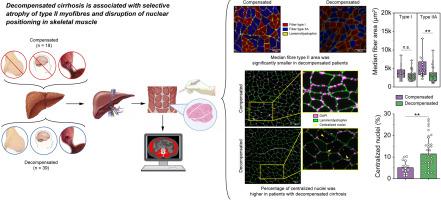Type II fibre atrophy and nuclear disruption in decompensated cirrhosis
IF 7.5
1区 医学
Q1 GASTROENTEROLOGY & HEPATOLOGY
引用次数: 0
Abstract
Background & Aims
Loss of skeletal muscle mass is a common complication in cirrhosis that is associated with higher morbidity and mortality. Since the specific pathophysiology of cirrhosis-related muscle loss is unclear, we performed histological evaluation of muscle tissue from patients with cirrhosis undergoing liver transplantation (LT).
Methods
Rectus abdominis muscle was collected at LT from 57 patients. Specimens were analyzed for immunohistochemical determination of fibre size and type, nuclear position and total tissue triglyceride. Computed tomography was used to determine the skeletal muscle index and sarcopenia was defined using previously published cut-offs. The D’Amico cirrhosis classification was used to categorize patients as having decompensated cirrhosis.
Results
At LT, 39 patients (68.4%) had decompensated cirrhosis. Decompensated cirrhosis was associated with reduced skeletal muscle index (females: 37.5 ± 4.5 vs. 44.4 ± 5.7 cm2/m2, p = 0.008; males: 44.6 ± 8.1 vs. 51.8 ± 7.4 cm2/m2, p = 0.029) and higher sarcopenia prevalence (59% vs. 22%, p = 0.01) compared to compensated cirrhosis. In patients with decompensated cirrhosis, the size of type IIA fibres was reduced by 35.7% (3,405 ± 1,894 vs. 5,295 ± 2,612 μm2, p = 0.003), the percentage of centralized nuclei was higher (11.6 ± 7.4 vs. 5.3 ± 3.0%, p <0.001), and total tissue triglyceride content was lower (19.0 ± 12.37 vs. 31.6 ± 12.77 μg/mg, p <0.001) than in patients with compensated cirrhosis. In the multivariate logistic regression analysis, size of type IIA fibres and percentage of centralized nuclei were independently associated with decompensated cirrhosis.
Conclusions
Patients with decompensated cirrhosis have myopathy characterized by fibre type II atrophy and disruption of nuclear positioning. Further work is warranted to evaluate the factors related to the development of muscle pathology in cirrhosis and to develop regimens of muscle rehabilitation for this patient population pre- and post-LT.
Impact and implications
Our study illustrates the presence of myopathy at the histological level in patients with cirrhosis undergoing liver transplantation. Patients with decompensated cirrhosis, compared with compensated cirrhosis, exhibit type II (glycolytic) muscle fibre atrophy and disruption of nuclear positioning. Patients with decompensated cirrhosis gain an extended survival benefit from liver transplantation but are likely to begin this extension of life enfeebled by loss of muscle mass and function. The involvement of glycolytic muscle fibres may have implications for strength and fatiguability; thus, post-transplant resistance exercise may help with rehabilitation.

失代偿性肝硬化的II型纤维萎缩和核破坏
背景,目的骨骼肌质量的减少是肝硬化的常见并发症,与较高的发病率和死亡率相关。由于肝硬化相关肌肉损失的具体病理生理学尚不清楚,我们对肝硬化肝移植(LT)患者的肌肉组织进行了组织学评估。方法对57例患者进行腰大腹直肌采集。对标本进行免疫组化分析,测定纤维大小和类型、核位置和总组织甘油三酯。使用计算机断层扫描来确定骨骼肌指数,并使用先前发表的截止值来定义肌肉减少症。D 'Amico肝硬化分级用于对失代偿性肝硬化患者进行分类。结果LT中39例(68.4%)出现失代偿性肝硬化。失代偿性肝硬化与骨骼肌指数降低相关(女性:37.5±4.5 vs 44.4±5.7 cm2/m2, p = 0.008;男性:44.6±8.1比51.8±7.4 cm2/m2, p = 0.029)和更高的肌肉减少患病率(59%比22%,p = 0.01)。失代偿性肝硬化患者IIA型纤维大小比代偿性肝硬化患者减少35.7%(3405±1894比5295±2612 μm2, p = 0.003),集中核比例较高(11.6±7.4比5.3±3.0%,p <0.001),组织总甘三酯含量较代偿性肝硬化患者低(19.0±12.37比31.6±12.77 μ mg, p <0.001)。在多变量logistic回归分析中,IIA型纤维的大小和集中核的百分比与失代偿性肝硬化独立相关。结论失代偿期肝硬化患者存在以纤维型萎缩和核定位破坏为特征的肌病。需要进一步的工作来评估肝硬化中肌肉病理发展的相关因素,并为这类患者在肝移植前后制定肌肉康复方案。影响和意义我们的研究表明肝硬化肝移植患者在组织学水平上存在肌病。失代偿性肝硬化患者与代偿性肝硬化患者相比,表现为II型(糖酵解)肌纤维萎缩和核定位紊乱。失代偿性肝硬化患者从肝移植中获得延长的生存期,但很可能在开始延长生命时因肌肉质量和功能的丧失而衰弱。糖酵解肌纤维的受累可能影响肌力和疲劳性;因此,移植后抗阻运动可能有助于康复。
本文章由计算机程序翻译,如有差异,请以英文原文为准。
求助全文
约1分钟内获得全文
求助全文
来源期刊

JHEP Reports
GASTROENTEROLOGY & HEPATOLOGY-
CiteScore
12.40
自引率
2.40%
发文量
161
审稿时长
36 days
期刊介绍:
JHEP Reports is an open access journal that is affiliated with the European Association for the Study of the Liver (EASL). It serves as a companion journal to the highly respected Journal of Hepatology.
The primary objective of JHEP Reports is to publish original papers and reviews that contribute to the advancement of knowledge in the field of liver diseases. The journal covers a wide range of topics, including basic, translational, and clinical research. It also focuses on global issues in hepatology, with particular emphasis on areas such as clinical trials, novel diagnostics, precision medicine and therapeutics, cancer research, cellular and molecular studies, artificial intelligence, microbiome research, epidemiology, and cutting-edge technologies.
In summary, JHEP Reports is dedicated to promoting scientific discoveries and innovations in liver diseases through the publication of high-quality research papers and reviews covering various aspects of hepatology.
 求助内容:
求助内容: 应助结果提醒方式:
应助结果提醒方式:


